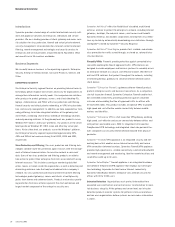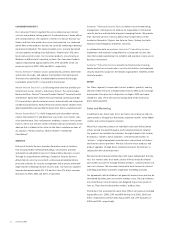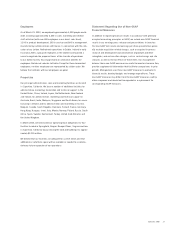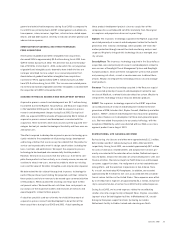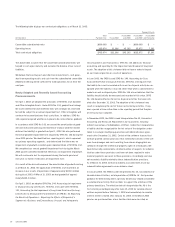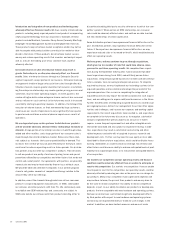Symantec 2003 Annual Report Download - page 30
Download and view the complete annual report
Please find page 30 of the 2003 Symantec annual report below. You can navigate through the pages in the report by either clicking on the pages listed below, or by using the keyword search tool below to find specific information within the annual report.
28 Symantec 2003
Overview
We have a 52/53-week fiscal accounting year. Accordingly, all references
as of and for the periods ended March 31, 2003, 2002 and 2001 reflect
amounts as of and for the periods ended March 28, 2003, March 29,
2002 and March 30, 2001, respectively. The fiscal accounting years
ended March 28, 2003, March 29, 2002 and March 30, 2001 each com-
prised 52 weeks of operations. The fiscal accounting year ending April 2,
2004 will comprise 53 weeks of operations, with the extra week coming
in the first quarter of fiscal 2004.
REVENUE RECOGNITION
We derive revenue primarily from sales of packaged software products,
perpetual software license agreements, product maintenance and
services, and recognize this revenue in accordance with Statement of
Position, or SOP, 97-2, Software Revenue Recognition, as modified by
SOP 98-9, and Staff Accounting Bulletin No. 101, Revenue Recognition
in Financial Statements, when the following conditions have been met:
•persuasive evidence of an arrangement exists;
•passage of title occurs;
•delivery has occurred or services have been rendered;
•if applicable, customer acceptance has been received;
•collection of a fixed or determinable license fee is considered
probable; and
•if appropriate, reasonable estimates of future product returns
have been made.
We sell packaged products, which primarily include consumer products,
through a multi-tiered distribution channel. We defer revenue on all dis-
tribution and reseller channel inventory in excess of specified inventory
levels in these channels. We defer a portion of revenue for product bun-
dled with content updates. This deferred revenue is recognized ratably
over the initial year that such updates are provided. We offer the right
of return of our products under various policies and programs with our
distributors, resellers and end-user customers. We estimate and record
reserves for end-user product returns and channel and end-user
rebates, and we account for these reserves as an offset to revenue.
We enter into perpetual software license agreements mainly for our
enterprise security and enterprise administration products primarily
through indirect sales with distributors and resellers. The license agree-
ments generally include product maintenance agreements, for which
the related revenue is deferred and recognized ratably over the period
of the agreements.
Our services include managed security services, consulting and educa-
tion. We recognize managed security services revenue ratably over the
period that such contracted services are provided. We recognize con-
sulting services revenue as services are performed or upon written
acceptance from customers, if applicable. We recognize education
services revenue as services are performed.
In arrangements that include perpetual software licenses and mainte-
nance and/or services, and packaged products with content updates
(“multiple elements”), we allocate and defer revenue for the undelivered
items based on vendor-specific objective evidence, or VSOE, of fair value
of the undelivered elements, and recognize the difference between the
total arrangement fee and the amount deferred for the undelivered
items as revenue. Our deferred revenue consists primarily of the
unamortized balance of enterprise product maintenance and consumer
product content updates.
VSOE of each element is based on the price for which the undelivered
element is sold separately. We determine fair value of the undelivered
elements based on historical evidence of our stand-alone sales of these
elements to third parties. If VSOE does not exist for undelivered items
such as maintenance or services, then the entire arrangement fee is
recognized ratably over the performance period.
CRITICAL ACCOUNTING POLICIES
In preparing our consolidated financial statements, we make estimates,
assumptions and judgments that can have a significant impact on our
reported amounts of net revenue, operating income and net income
(loss), as well as on the value of certain assets on our consolidated
balance sheet. We believe that the estimates, assumptions and judg-
ments involved in the accounting policies described below have the
greatest potential impact on our consolidated financial statements, so
we consider these to be our critical accounting policies. See “Summary
of Significant Accounting Policies” beginning on page 48 in the consoli-
dated financial statements for more information about these critical
accounting policies, as well as descriptions of other significant account-
ing policies. We have engaged in discussions with our audit committee
of the Board of Directors regarding the development, selection and
disclosure of our critical accounting policies.
Channel Revenue Deferrals We defer revenue relating to products,
primarily in our Consumer and Enterprise Administration segments,
that we have shipped into our distribution and reseller channels to the
extent that inventory levels are in excess of certain specified inventory
levels for these channels. We defer this revenue as an offset to accounts
receivable. We estimate the excess inventory in these channels by ana-
lyzing channel inventory levels and distribution sell-through trends
obtained from our channel partners, as well as various historical trends
on a product basis. In addition, we consider other factors in assessing
these specified inventory levels, such as product seasonality, current
market conditions, economic trends, existing security threats and timing
of new product releases. On the same basis, we defer the associated
cost of revenues related to the channel revenue deferral. If we made
different judgments or utilized different estimates, material differences
may result in the amount and timing of our net revenues and cost of
revenues for any period presented.
Reserves for Product Returns End-users may return our products,
primarily within our Consumer and Enterprise Administration segments,
through distributors and resellers or to us directly for a full refund
within a reasonably short period from the date of purchase. Our
Management’s Discussion and Analysis of Financial Condition and Results of Operations




